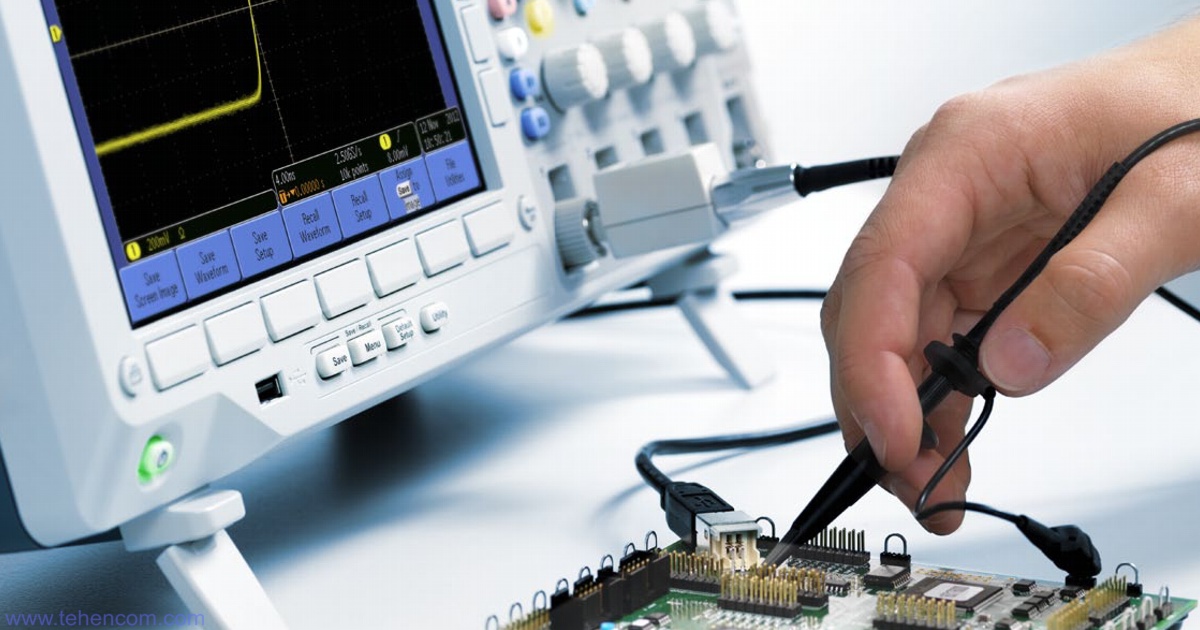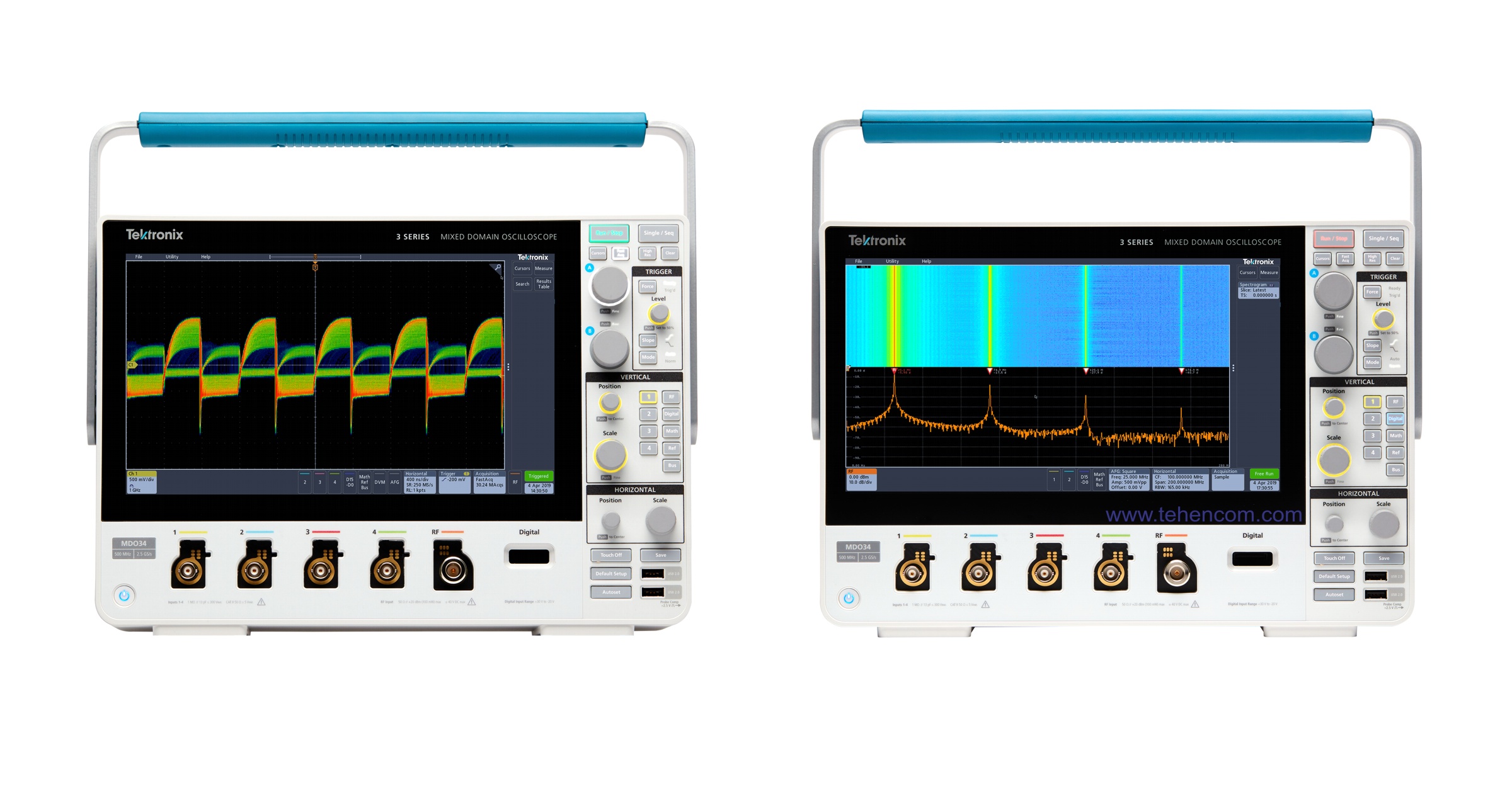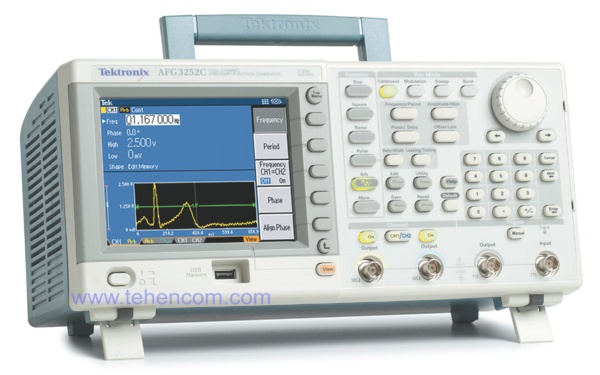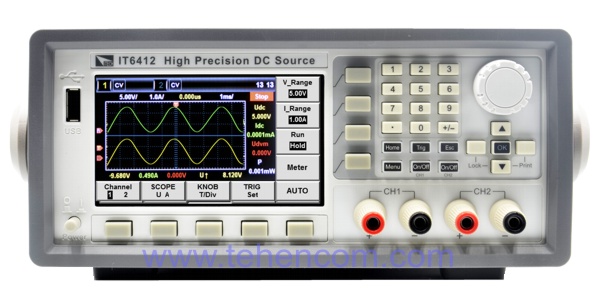Oscilloscopes
-
Top sales
 Pico Technology 2206B MSO
Pico Technology 2206B MSOOscilloscope, 50 MHz, 2 + 16 channels, 1 GS/s
From 35 592 UAH
In stock
Product code: 3030007
Record length: 32 M points
Vertical resolution: 8 bits
Waveforms per second: 80 000
An inexpensive oscilloscope with large memory and a 16-channel logic analyzer.
-
NoveltyPromotionTop sales
 Pico Technology 3417E MSO
Pico Technology 3417E MSOOscilloscope, 350 MHz, 4 + 16 channels, 5 GS/s
From 193 301 UAH
–5%
From 183 636 UAH
Coming soon
Product code: 3030107
Record length: 2 000 M points
Vertical resolution: 8 – 10 bits
Waveforms per second: 300 000
-
NoveltyTop sales
 Micsig MHO14-200N
Micsig MHO14-200NOscilloscope, 200 MHz, 4 channels, 1 GS/s
From 31 026 UAH
Coming soon
Product code: 3030119
Record length: 110 M points
Vertical resolution: 12 bits
Waveforms per second: 50 000
-
NoveltyExpert's choice
 Micsig MHO14-200
Micsig MHO14-200Oscilloscope, 200 MHz, 4 channels, 1 GS/s
From 37 404 UAH
Coming soon
Product code: 3030118
Record length: 110 M points
Vertical resolution: 12 bits
Waveforms per second: 50 000
-
Top sales
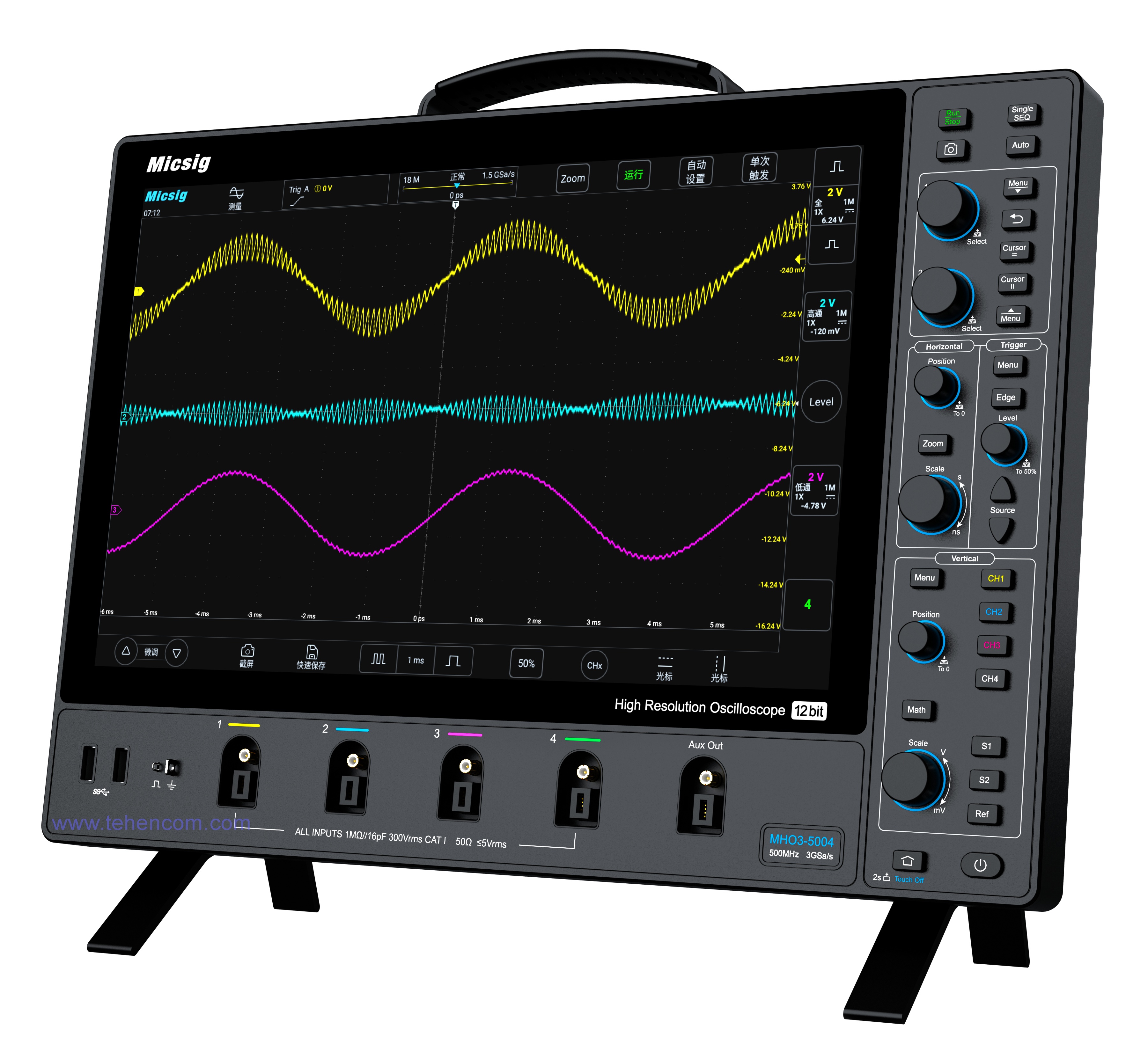 Micsig MHO3-5004
Micsig MHO3-5004Oscilloscope, 500 MHz, 4 channels, 3 GS/s
From 140 250 UAH
Coming soon
Product code: 3030115
Record length: 360 M points
Vertical resolution: 12 bits
Waveforms per second: 230 000
-
NoveltyPromotionTop sales
 Pico Technology 3416E MSO
Pico Technology 3416E MSOOscilloscope, 200 MHz, 4 + 16 channels, 5 GS/s
From 133 402 UAH
–5%
From 126 732 UAH
On order
Product code: 3030105
Record length: 2 000 M points
Vertical resolution: 8 – 10 bits
Waveforms per second: 300 000
-
Promotion
 Pico Technology 6424E
Pico Technology 6424EOscilloscope, 500 MHz, 4 + 16 channels, 5 GS/s
From 420 505 UAH
–5%
From 399 480 UAH
On order
Product code: 3030022
Record length: 4 000 M points
Vertical resolution: 8 – 12 bits
Waveforms per second: 300 000
Digital oscilloscope with high-resolution ADC, performs 15 automatic measurements.
-
NoveltyTop sales
 Micsig MHO68-1000
Micsig MHO68-1000Oscilloscope, 1 GHz, 8 channels, 6 GS/s
From 828 750 UAH
On order
Product code: 3030112
Record length: 1 800 M points
Vertical resolution: 12 bits
Waveforms per second: 280 000
-
NoveltyTop sales
 Micsig MHO68-350
Micsig MHO68-350Oscilloscope, 350 MHz, 8 channels, 6 GS/s
From 637 080 UAH
On order
Product code: 3030110
Record length: 1 800 M points
Vertical resolution: 12 bits
Waveforms per second: 280 000
-
Top sales
 Pico Technology 2208B MSO
Pico Technology 2208B MSOOscilloscope, 100 MHz, 2 + 16 channels, 1 GS/s
From 55 194 UAH
On order
Product code: 3030013
Record length: 128 M points
Vertical resolution: 8 bits
Waveforms per second: 80 000
-
NoveltyExpert's choice
 Pico Technology 3415E MSO
Pico Technology 3415E MSOOscilloscope, 100 MHz, 4 + 16 channels, 5 GS/s
From 112 614 UAH
On order
Product code: 3030103
Record length: 2 000 M points
Vertical resolution: 8 – 10 bits
Waveforms per second: 300 000
-
Top sales
 Tektronix MSO22-BW-100
Tektronix MSO22-BW-100Oscilloscope, 100 MHz, 2 + 16 channels, 2.5 GS/s
From 113 904 UAH
On order
Product code: 3030094
Record length: 40 M points
Vertical resolution: 8 bits
Waveforms per second: 100
Excellent digital oscilloscope with autonomous power supply, performs 37 automatic measurements.
-
Expert's choice
 Tektronix MSO24-BW-100
Tektronix MSO24-BW-100Oscilloscope, 100 MHz, 4 + 16 channels, 2.5 GS/s
From 161 928 UAH
On order
Product code: 3030095
Record length: 40 M points
Vertical resolution: 8 bits
Waveforms per second: 100
Digital oscilloscope with autonomous power supply and advanced measurement capabilities.
-
Top sales
 Tektronix MDO34-BW-200
Tektronix MDO34-BW-200Oscilloscope, 200 MHz, 4 + 16 channels, 2.5 GS/s
From 287 304 UAH
On order
Product code: 3030085
Record length: 40 M points 50 M points
Vertical resolution: 8 bits
Waveforms per second: 235 000
Spectrum analysis: 9 kHz – 1 GHz 9 kHz – 3 GHz
Professional digital oscilloscope with built-in spectrum analyzer.
-
Top sales
 Pico Technology 5243D
Pico Technology 5243DOscilloscope, 100 MHz, 2 channels, 1 GS/s
From 87 864 UAH
On order
Product code: 3030038
Record length: 256 M points
Vertical resolution: 8 – 16 bits
Waveforms per second: 130 000
-
Expert's choice
 Tektronix MSO24-BW-200
Tektronix MSO24-BW-200Oscilloscope, 200 MHz, 4 + 16 channels, 2.5 GS/s
From 196 350 UAH
On order
Product code: 3030097
Record length: 40 M points
Vertical resolution: 8 bits
Waveforms per second: 100
Excellent oscilloscope with autonomous power supply and advanced measurement capabilities.
-
NoveltyExpert's choice
 Pico Technology 3418E MSO
Pico Technology 3418E MSOOscilloscope, 500 MHz, 4 + 16 channels, 5 GS/s
From 235 374 UAH
On order
Product code: 3030109
Record length: 2 000 M points
Vertical resolution: 8 – 10 bits
Waveforms per second: 300 000
-
Expert's choice
 Pico Technology 5244D
Pico Technology 5244DOscilloscope, 200 MHz, 2 channels, 1 GS/s
From 105 192 UAH
On order
Product code: 3030042
Record length: 512 M points
Vertical resolution: 8 – 16 bits
Waveforms per second: 130 000
-
Expert's choice
 Pico Technology 5444D MSO
Pico Technology 5444D MSOOscilloscope, 200 MHz, 4 + 16 channels, 1 GS/s
From 161 124 UAH
On order
Product code: 3030045
Record length: 512 M points
Vertical resolution: 8 – 16 bits
Waveforms per second: 130 000
High-quality digital oscilloscope with hardware ADC resolution up to 16 bits.
-
Expert's choice
 Tektronix DPO72004DX
Tektronix DPO72004DXOscilloscope, 20 GHz, 4 channels, 100 GS/s
Price on request
On order
Product code: 3030052
Record length: 250 M points 2 000 M points
Vertical resolution: 8 bits
Waveforms per second: 300 000
High frequency oscilloscope with unique signal analysis capabilities.
-
Expert's choice
 Tektronix MSO70804DX
Tektronix MSO70804DXOscilloscope, 8 GHz, 4 + 16 channels, 100 GS/s
Price on request
On order
Product code: 3030047
Record length: 312.5 M points 2 500 M points
Vertical resolution: 8 bits
Waveforms per second: 300 000
Oscilloscope for working with analog and digital signals in the gigahertz range.
-
Expert's choice
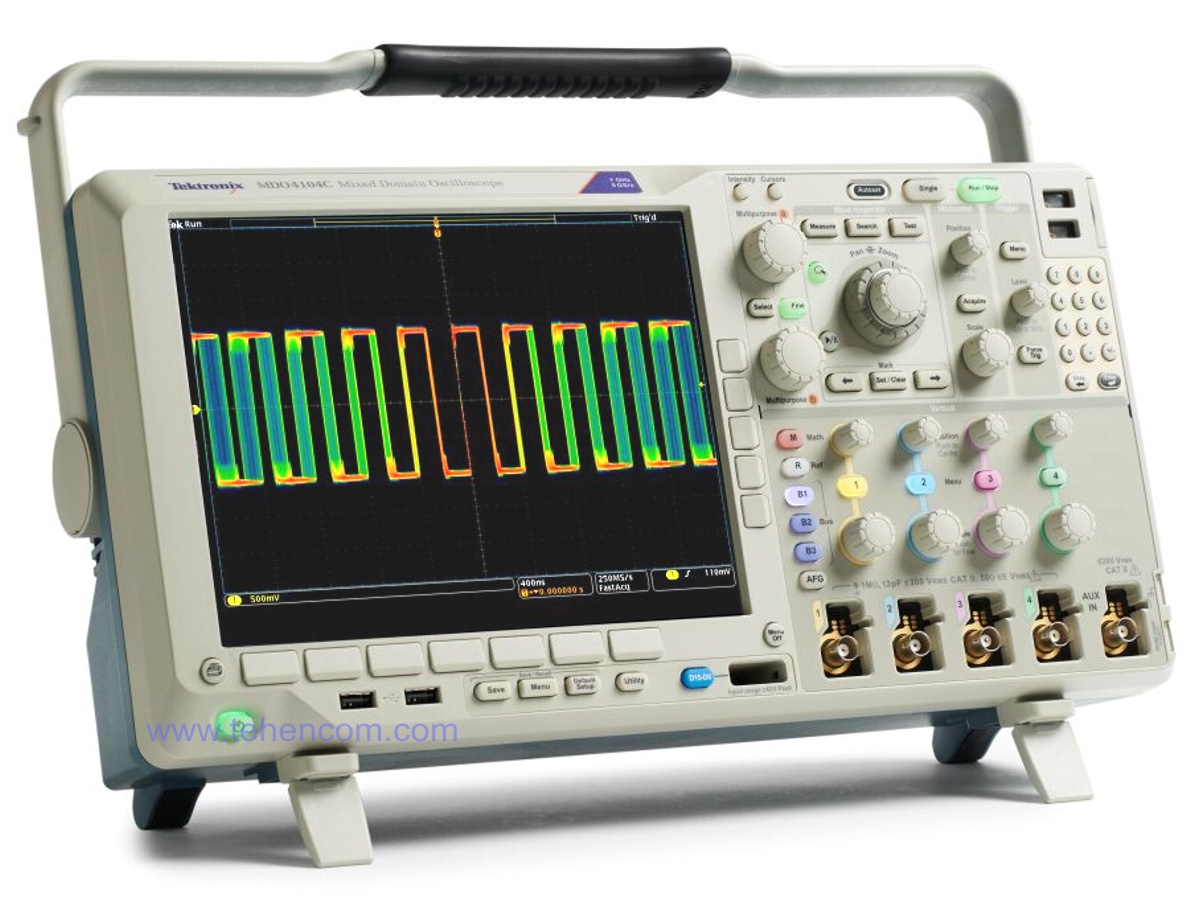 Tektronix MDO4104C
Tektronix MDO4104COscilloscope, 1 GHz, 4 + 16 channels, 5 GS/s
Price on request
On order
Product code: 3030033
Record length: 80 M points 100 M points
Vertical resolution: 8 bits
Waveforms per second: 340 000
Spectrum analysis: 9 kHz – 3 GHz 9 kHz – 6 GHz
Functional oscilloscope for measuring conventional and RF signals.
-
Expert's choice
 Pico Technology 6824E
Pico Technology 6824EOscilloscope, 500 MHz, 8 + 16 channels, 5 GS/s
Price on request
On order
Product code: 3030024
Record length: 4 000 M points
Vertical resolution: 8 – 12 bits
Waveforms per second: 300 000
-
Expert's choice
 Tektronix MDO32-BW-1000
Tektronix MDO32-BW-1000Oscilloscope, 1 GHz, 2 + 16 channels, 5 GS/s
Price on request
On order
Product code: 3030090
Record length: 20 M points 30 M points
Vertical resolution: 8 bits
Waveforms per second: 280 000
Spectrum analysis: 9 kHz – 1 GHz 9 kHz – 3 GHz
Professional digital oscilloscope with built-in spectrum analyzer.
-
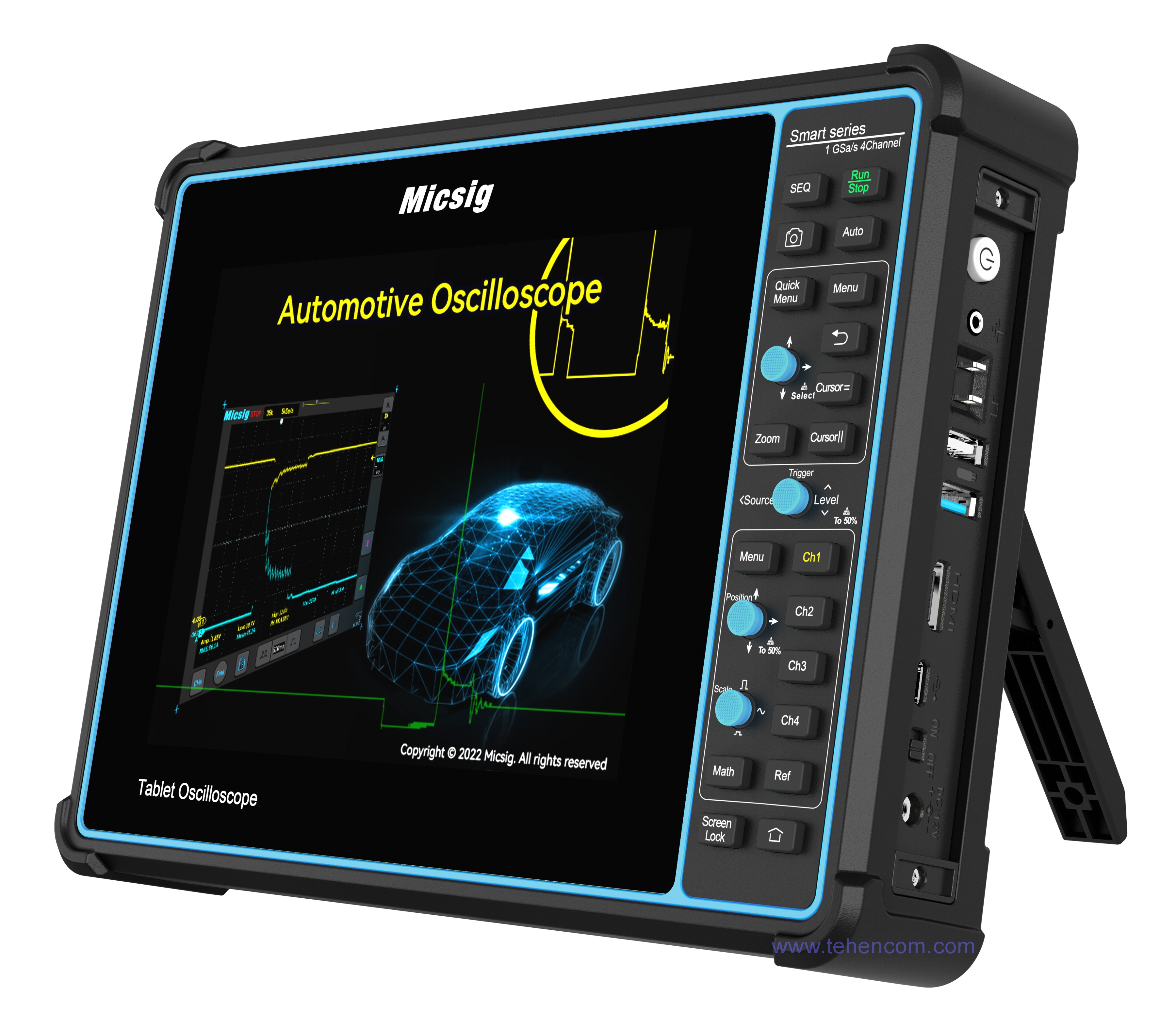 Micsig SATO2002
Micsig SATO2002Oscilloscope, 200 MHz, 2 channels, 1 GS/s
From 38 040 UAH
On order
Product code: 3030125
Record length: 70 M points
Vertical resolution: 8 bits
Waveforms per second: 130 000
-
 Micsig SATO1004
Micsig SATO1004Oscilloscope, 100 MHz, 4 channels, 1 GS/s
From 41 226 UAH
On order
Product code: 3030124
Record length: 70 M points
Vertical resolution: 8 bits
Waveforms per second: 130 000
-
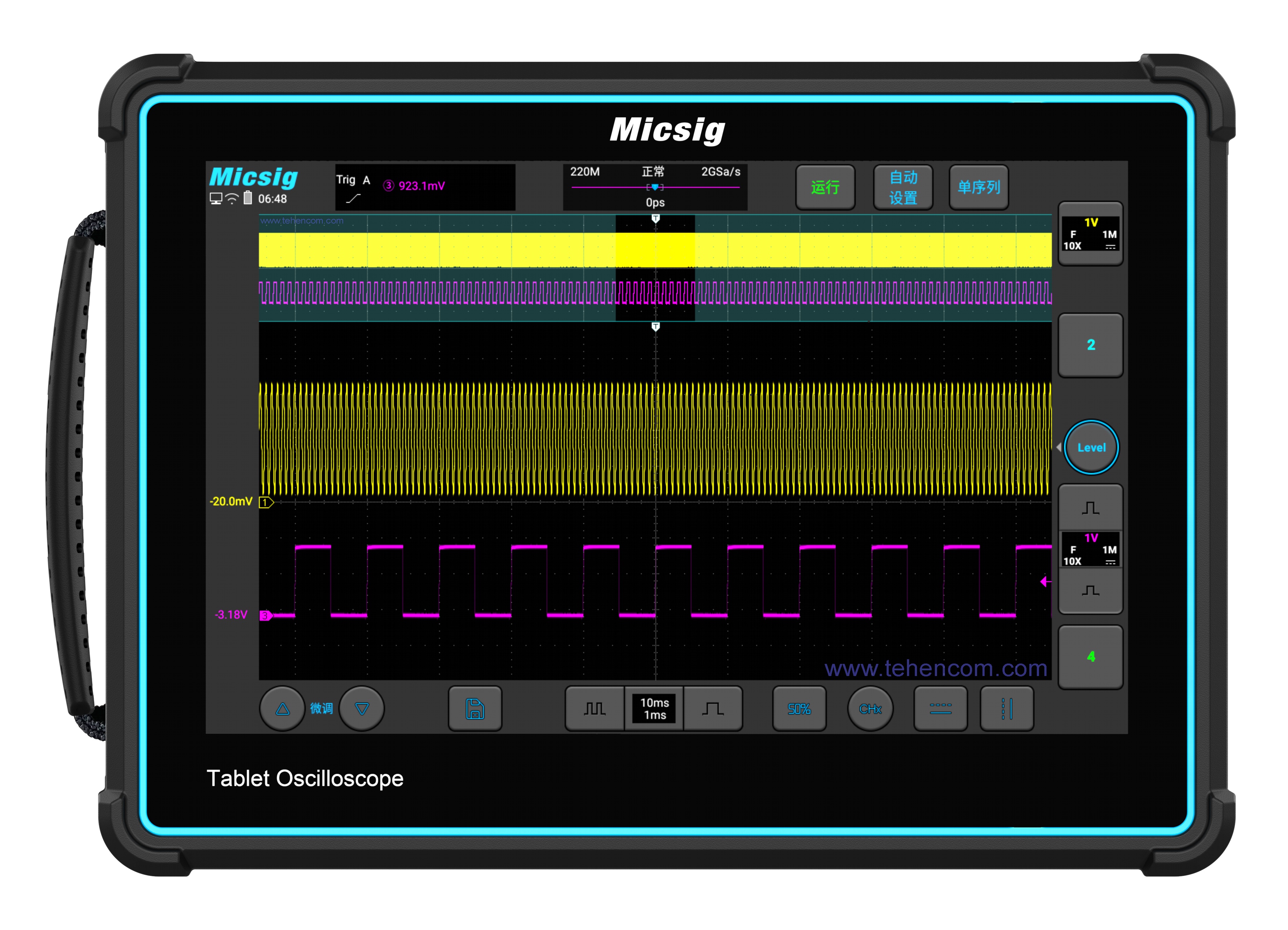 Micsig TO3004
Micsig TO3004Oscilloscope, 300 MHz, 4 channels, 2 GS/s
From 55 254 UAH
On order
Product code: 3030123
Record length: 220 M points
Vertical resolution: 8 bits
Waveforms per second: 300 000
-
 Micsig TO2004
Micsig TO2004Oscilloscope, 200 MHz, 4 channels, 2 GS/s
From 51 000 UAH
On order
Product code: 3030122
Record length: 220 M points
Vertical resolution: 8 bits
Waveforms per second: 300 000
-
 Micsig TO2002
Micsig TO2002Oscilloscope, 200 MHz, 2 channels, 1 GS/s
From 29 328 UAH
On order
Product code: 3030121
Record length: 110 M points
Vertical resolution: 8 bits
Waveforms per second: 78 000
-
 Micsig TO1004
Micsig TO1004Oscilloscope, 100 MHz, 4 channels, 1 GS/s
From 31 878 UAH
On order
Product code: 3030120
Record length: 110 M points
Vertical resolution: 8 bits
Waveforms per second: 78 000
-
Novelty
 Micsig MHO14-100N
Micsig MHO14-100NOscilloscope, 100 MHz, 4 channels, 1 GS/s
From 30 180 UAH
On order
Product code: 3030117
Record length: 110 M points
Vertical resolution: 12 bits
Waveforms per second: 50 000
-
Novelty
 Micsig MHO14-100
Micsig MHO14-100Oscilloscope, 100 MHz, 4 channels, 1 GS/s
From 36 552 UAH
On order
Product code: 3030116
Record length: 110 M points
Vertical resolution: 12 bits
Waveforms per second: 50 000
-
 Micsig MHO3-3504
Micsig MHO3-3504Oscilloscope, 350 MHz, 4 channels, 3 GS/s
From 131 754 UAH
On order
Product code: 3030114
Record length: 360 M points
Vertical resolution: 12 bits
Waveforms per second: 230 000
-
 Micsig MHO3-2504
Micsig MHO3-2504Oscilloscope, 250 MHz, 4 channels, 3 GS/s
From 114 750 UAH
On order
Product code: 3030113
Record length: 360 M points
Vertical resolution: 12 bits
Waveforms per second: 230 000
-
Novelty
 Micsig MHO68-500
Micsig MHO68-500Oscilloscope, 500 MHz, 8 channels, 6 GS/s
From 701 250 UAH
On order
Product code: 3030111
Record length: 1 800 M points
Vertical resolution: 12 bits
Waveforms per second: 280 000
-
Novelty
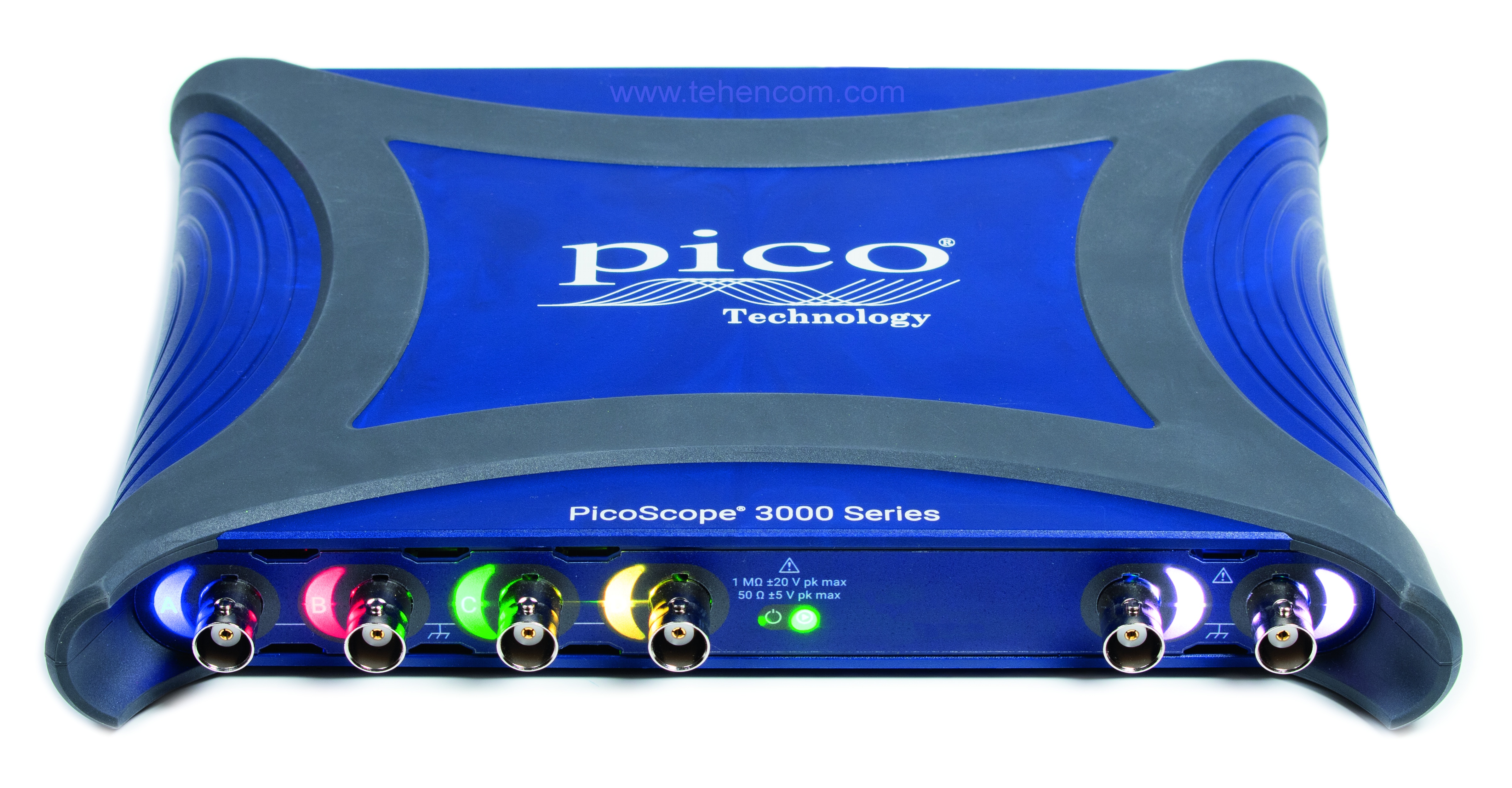 Pico Technology 3415E
Pico Technology 3415EOscilloscope, 100 MHz, 4 channels, 5 GS/s
From 91 332 UAH
On order
Product code: 3030102
Record length: 2 000 M points
Vertical resolution: 8 – 10 bits
Waveforms per second: 300 000
General information
A digital oscilloscope is an indispensable instrument for any laboratory, with which you can directly observe, record and analyze electrical signals. Thanks to continuous improvement and the addition of new functions, modern digital oscilloscopes successfully solve more and more practical problems. We offer hundreds of oscilloscope models from 10 MHz to 80 GHz: classic laboratory, USB, portable and rackmount. In addition to conventional real-time oscilloscopes, the offer also includes sampling oscilloscopes, which are excellent for studying periodic signals.
Best models
This table contains the best models of oscilloscopes with the status of Top sales or Expert's choice. Such models have a high price / capability ratio, so they should be paid attention first of all. The table is interactive, any column can be sorted in ascending or descending order.
| Model |
Bandwidth
|
Analog channels
|
Digital channels
|
Sample rate
|
Vertical resolution
|
Waveforms per second
|
|---|---|---|---|---|---|---|
|
Top sales
|
50 MHz | 2 | 16 | 1 GS/s | 8 bits | 80 000 |
|
Top sales
|
100 MHz | 2 | 16 | 1 GS/s | 8 bits | 80 000 |
|
Expert's choice
|
500 MHz | 8 | 8 16 | 5 GS/s | 8 – 12 bits | 300 000 |
|
Expert's choice
|
1 GHz | 4 | 16 | 5 GS/s | 8 bits | 340 000 |
|
Top sales
|
100 MHz | 2 | — | 1 GS/s | 8 – 16 bits | 130 000 |
|
Expert's choice
|
200 MHz | 2 | — | 1 GS/s | 8 – 16 bits | 130 000 |
|
Expert's choice
|
200 MHz | 4 | 16 | 1 GS/s | 8 – 16 bits | 130 000 |
|
Expert's choice
|
8 GHz | 4 | 16 | 100 GS/s | 8 bits | 300 000 |
|
Expert's choice
|
20 GHz | 4 | — | 100 GS/s | 8 bits | 300 000 |
|
Top sales
|
200 MHz | 4 | 16 | 2.5 GS/s | 8 bits | 235 000 |
|
Expert's choice
|
1 GHz | 2 | 16 | 5 GS/s | 8 bits | 280 000 |
|
Top sales
|
100 MHz | 2 | 16 | 2.5 GS/s | 8 bits | 100 |
|
Expert's choice
|
100 MHz | 4 | 16 | 2.5 GS/s | 8 bits | 100 |
|
Expert's choice
|
200 MHz | 4 | 16 | 2.5 GS/s | 8 bits | 100 |
|
Novelty
Expert's choice
|
100 MHz | 4 | 16 | 5 GS/s | 8 – 10 bits | 300 000 |
|
Novelty
Promotion
Top sales
|
200 MHz | 4 | 16 | 5 GS/s | 8 – 10 bits | 300 000 |
|
Novelty
Promotion
Top sales
|
350 MHz | 4 | 16 | 5 GS/s | 8 – 10 bits | 300 000 |
|
Novelty
Expert's choice
|
500 MHz | 4 | 16 | 5 GS/s | 8 – 10 bits | 300 000 |
All models of oscilloscopes
This table shows all models of oscilloscopes. You can sort by any of the characteristics by simply clicking on its name in the table. To see all the characteristics of certain models, add them to the comparison.
| Model |
Bandwidth
|
Analog channels
|
Digital channels
|
Sample rate
|
Vertical resolution
|
Waveforms per second
|
|---|---|---|---|---|---|---|
| 10 MHz | 2 | — | 100 MS/s | 8 bits | 2 000 | |
| 25 MHz | 2 | — | 200 MS/s | 8 bits | 2 000 | |
| 25 MHz | 4 | — | 500 MS/s | 8 bits | 2 000 | |
| 25 MHz | 2 | 16 | 500 MS/s | 8 bits | 2 000 | |
| 50 MHz | 2 | — | 500 MS/s | 8 bits | 80 000 | |
| 50 MHz | 4 | — | 1 GS/s | 8 bits | 80 000 | |
|
Top sales
|
50 MHz | 2 | 16 | 1 GS/s | 8 bits | 80 000 |
| 70 MHz | 2 | — | 1 GS/s | 8 bits | 80 000 | |
| 70 MHz | 4 | — | 1 GS/s | 8 bits | 80 000 | |
| 70 MHz | 2 | 16 | 1 GS/s | 8 bits | 80 000 | |
| 100 MHz | 2 | — | 1 GS/s | 8 bits | 80 000 | |
| 100 MHz | 4 | — | 1 GS/s | 8 bits | 80 000 | |
|
Top sales
|
100 MHz | 2 | 16 | 1 GS/s | 8 bits | 80 000 |
| 70 MHz | 2 | — | 2 GS/s | 8 bits | 100 | |
| 70 MHz | 4 | — | 2 GS/s | 8 bits | 100 | |
| 100 MHz | 2 | — | 2 GS/s | 8 bits | 100 | |
| 100 MHz | 4 | — | 2 GS/s | 8 bits | 100 | |
| 200 MHz | 2 | — | 2 GS/s | 8 bits | 100 | |
| 200 MHz | 4 | — | 2 GS/s | 8 bits | 100 | |
| 300 MHz | 4 | 8 16 | 2.5 GS/s | 8 bits | 300 000 | |
| 500 MHz | 4 | 8 16 | 5 GS/s | 8 bits | 300 000 | |
|
Promotion
|
500 MHz | 4 | 8 16 | 5 GS/s | 8 – 12 bits | 300 000 |
| 500 MHz | 8 | 8 16 | 5 GS/s | 8 bits | 300 000 | |
|
Expert's choice
|
500 MHz | 8 | 8 16 | 5 GS/s | 8 – 12 bits | 300 000 |
| 750 MHz 500 MHz | 4 | 8 16 | 5 GS/s | 8 bits | 300 000 | |
| 750 MHz 500 MHz | 4 | 8 16 | 5 GS/s | 8 – 12 bits | 300 000 | |
| 1 GHz 500 MHz | 4 | 8 16 | 5 GS/s | 8 bits | 300 000 | |
| 1 GHz 500 MHz | 4 | 8 16 | 5 GS/s | 8 – 12 bits | 300 000 | |
|
Novelty
|
3 GHz | 4 | 8 16 | 10 GS/s | 8 – 12 bits | 300 000 |
| 200 MHz | 4 | 16 | 2.5 GS/s | 8 bits | 340 000 | |
| 350 MHz | 4 | 16 | 2.5 GS/s | 8 bits | 340 000 | |
| 500 MHz | 4 | 16 | 2.5 GS/s | 8 bits | 340 000 | |
|
Expert's choice
|
1 GHz | 4 | 16 | 5 GS/s | 8 bits | 340 000 |
| 60 MHz | 2 | — | 1 GS/s | 8 – 16 bits | 130 000 | |
| 60 MHz | 2 | 16 | 1 GS/s | 8 – 16 bits | 130 000 | |
| 60 MHz | 4 | — | 1 GS/s | 8 – 16 bits | 130 000 | |
| 60 MHz | 4 | 16 | 1 GS/s | 8 – 16 bits | 130 000 | |
|
Top sales
|
100 MHz | 2 | — | 1 GS/s | 8 – 16 bits | 130 000 |
| 100 MHz | 2 | 16 | 1 GS/s | 8 – 16 bits | 130 000 | |
| 100 MHz | 4 | — | 1 GS/s | 8 – 16 bits | 130 000 | |
| 100 MHz | 4 | 16 | 1 GS/s | 8 – 16 bits | 130 000 | |
|
Expert's choice
|
200 MHz | 2 | — | 1 GS/s | 8 – 16 bits | 130 000 |
| 200 MHz | 2 | 16 | 1 GS/s | 8 – 16 bits | 130 000 | |
| 200 MHz | 4 | — | 1 GS/s | 8 – 16 bits | 130 000 | |
|
Expert's choice
|
200 MHz | 4 | 16 | 1 GS/s | 8 – 16 bits | 130 000 |
| 8 GHz | 4 | — | 100 GS/s | 8 bits | 300 000 | |
|
Expert's choice
|
8 GHz | 4 | 16 | 100 GS/s | 8 bits | 300 000 |
| 12.5 GHz | 4 | — | 100 GS/s | 8 bits | 300 000 | |
| 12.5 GHz | 4 | 16 | 100 GS/s | 8 bits | 300 000 | |
| 16 GHz | 4 | — | 100 GS/s | 8 bits | 300 000 | |
| 16 GHz | 4 | 16 | 100 GS/s | 8 bits | 300 000 | |
|
Expert's choice
|
20 GHz | 4 | — | 100 GS/s | 8 bits | 300 000 |
| 20 GHz | 4 | 16 | 100 GS/s | 8 bits | 300 000 | |
| 23 GHz | 4 | — | 100 GS/s | 8 bits | 300 000 | |
| 23 GHz | 4 | 16 | 100 GS/s | 8 bits | 300 000 | |
| 25 GHz | 4 | — | 100 GS/s | 8 bits | 300 000 | |
| 25 GHz | 4 | 16 | 100 GS/s | 8 bits | 300 000 | |
| 33 GHz | 4 | — | 100 GS/s | 8 bits | 300 000 | |
| 33 GHz | 4 | 16 | 100 GS/s | 8 bits | 300 000 | |
| 100 MHz | 2 | 16 | 2.5 GS/s | 8 bits | 235 000 | |
| 100 MHz | 4 | 16 | 2.5 GS/s | 8 bits | 235 000 | |
| 200 MHz | 2 | 16 | 2.5 GS/s | 8 bits | 235 000 | |
|
Top sales
|
200 MHz | 4 | 16 | 2.5 GS/s | 8 bits | 235 000 |
| 350 MHz | 2 | 16 | 2.5 GS/s | 8 bits | 235 000 | |
| 350 MHz | 4 | 16 | 2.5 GS/s | 8 bits | 235 000 | |
| 500 MHz | 2 | 16 | 2.5 GS/s | 8 bits | 235 000 | |
| 500 MHz | 4 | 16 | 2.5 GS/s | 8 bits | 235 000 | |
|
Expert's choice
|
1 GHz | 2 | 16 | 5 GS/s | 8 bits | 280 000 |
| 1 GHz | 4 | 16 | 5 GS/s | 8 bits | 280 000 | |
| 70 MHz | 2 | 16 | 2.5 GS/s | 8 bits | 100 | |
| 70 MHz | 4 | 16 | 2.5 GS/s | 8 bits | 100 | |
|
Top sales
|
100 MHz | 2 | 16 | 2.5 GS/s | 8 bits | 100 |
|
Expert's choice
|
100 MHz | 4 | 16 | 2.5 GS/s | 8 bits | 100 |
| 200 MHz | 2 | 16 | 2.5 GS/s | 8 bits | 100 | |
|
Expert's choice
|
200 MHz | 4 | 16 | 2.5 GS/s | 8 bits | 100 |
| 350 MHz | 2 | 16 | 2.5 GS/s | 8 bits | 100 | |
| 350 MHz | 4 | 16 | 2.5 GS/s | 8 bits | 100 | |
|
Novelty
|
500 MHz | 2 | 16 | 2.5 GS/s | 8 bits | 100 |
|
Novelty
|
500 MHz | 4 | 16 | 2.5 GS/s | 8 bits | 100 |
|
Novelty
|
100 MHz | 4 | — | 5 GS/s | 8 – 10 bits | 300 000 |
|
Novelty
Expert's choice
|
100 MHz | 4 | 16 | 5 GS/s | 8 – 10 bits | 300 000 |
|
Novelty
|
200 MHz | 4 | — | 5 GS/s | 8 – 10 bits | 300 000 |
|
Novelty
Promotion
Top sales
|
200 MHz | 4 | 16 | 5 GS/s | 8 – 10 bits | 300 000 |
|
Novelty
|
350 MHz | 4 | — | 5 GS/s | 8 – 10 bits | 300 000 |
|
Novelty
Promotion
Top sales
|
350 MHz | 4 | 16 | 5 GS/s | 8 – 10 bits | 300 000 |
|
Novelty
|
500 MHz | 4 | — | 5 GS/s | 8 – 10 bits | 300 000 |
|
Novelty
Expert's choice
|
500 MHz | 4 | 16 | 5 GS/s | 8 – 10 bits | 300 000 |
Additional equipment
In addition to the main list of oscilloscopes presented above, the following additional series are produced: PicoScope 3000D (USB, up to 200 MHz), with a built-in spectrum analyzer Tektronix MDO3, six-channel Tektronix MSO4 (up to 1.5 GHz), eight-channel Tektronix MSO5 (up to 2 GHz) and the most functional Tektronix MSO6 (up to 8 GHz).
Manufacturers of measuring equipment regularly develop and launch new models of oscilloscopes with expanded capabilities and improved performance. Some time after the start of sales of new models, old models and series are discontinued. A complete list of discontinued oscilloscopes, including proposed replacements, can be found here: discontinued oscilloscopes.
Video reviews
Better to see once than hear a hundred times. This video collection from our YouTube channel is dedicated exclusively to digital oscilloscopes: new products, interesting models, features of their application, standards and measurement techniques. We are constantly updating and supplementing this collection with new interesting materials on oscilloscope measurements and related topics. Subscribe to our channel to stay updated: YouTube channel of Tehencom.
Basic theory
Buying an inexpensive and high-quality oscilloscope is not always easy. When choosing a model, in addition to the standard parameters: number of channels, bandwidth and sample rate, it is necessary to take into account additional characteristics and capabilities of the oscilloscope: record length, sensitivity, speed of continuous waveform acquisition, presence of digital channels, type of built-in spectrum analyzer, standard measurements (period, frequency, delay, rise time, etc.), possibility and ease of programming, built-in digital interfaces, a set of additional functions, operating temperature range, quality and durability of the device, the reputation of the manufacturer, the professionalism and reliability of the supplier, the availability of a service center, warranty period and much more. In addition, you may need technical advice on the types of oscilloscopes produced: real-time and sampling.
The next section Documentation contains useful information on the theory and practice of using digital oscilloscopes, which will help you understand this issue and improve your professional level. For complex and unclear issues, write to us by e-mail or call, we will be happy to advise.
Documentation and useful materials
-
Tutorial on the basics of oscilloscope measurements
RU, 60 pages, 2 MB
-
Tutorial on the oscilloscope probes
RU, 60 pages, 4 MB
-
12 things to consider when choosing an oscilloscope
RU, 30 pages, 7 MB
-
Probes selection guide for Tektronix oscilloscopes
EN, 23 pages, 4 MB
Need help choosing equipment?
To simplify the process of choosing the optimal set of equipment, you can use our experience and recommendations. We have more than 20 years of practical supply experience and we can immediately answer many questions about models, options, terms, prices and discounts. This will save your time and money. To do this, just contact us or order a free consultation and we will be happy to answer your questions.
